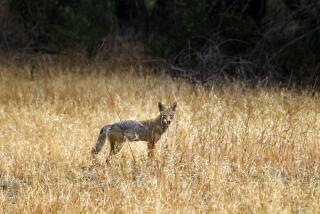Abandoned Bobcat Raised to Be Wild, or So Human Cat Imitators Hope : Northern California: Kitten was found sitting in the middle of the road and taken to a wildlife center. There, attendants wore urine-scented cat suits and tried to instill a fear of people in the animal.
- Share via
SAN FRANCISCO — For Elena Macias, seeing the freed bobcat run from her in fear made all the hours in a urine-soaked cat suit worthwhile.
Faced six months before with the problem of raising the foundling bobcat without overriding the predator’s natural aversion to humans, Macias and colleagues at the Wildlife Education and Rehabilitation Center expanded on the mimicry and masking used to raise wild birds for release.
For the wildlife workers, that meant acting, dressing and smelling the part of a jumbo surrogate bobcat.
Wearing a fake fur outfit patterned on a Pink Panther Halloween costume and masked in the smell of herbs and the bobcat’s own urine, eight humans coached a wild kitten on playing and grooming and on stalking and killing rats as it would squirrels in the wild.
“We did some research, and from there . . . basically we played it by ear,” said Macias, operations manager at the Morgan Hill center.
“We knew we had to be on all fours. Basically be a big cat,” she said.
“I did draw the line against licking her. And, no, we didn’t put the rats in our mouths, either.”
Wildcats have been raised before with the aim of preserving their wild instincts. But the center’s use of costuming and bobcat role-playing has others in the wildlife field awaiting word on the outcome of the project.
The experiment, conducted with the approval of state game officials, began when motorists in the Santa Cruz Mountains found a 10- to 12-week-old bobcat sitting in the middle of a road.
The kitten should have been moved to the side of the road and left, said Sue Howell, the wildlife center’s director. Instead, the kitten wound up with the center.
Born after the normal spring season for litters, the kitten could not be matched with other captive bobcats, by far the preferred method of raising a stranded wildcat, Howell said.
Ethically, Howell said, center workers could not simply tend the kitten and release it as a tame adult that would look to people for handouts or ready-to-eat poultry and pets.
“When it came down to our choices, it was, do we raise this singular bobcat alone . . . or do we place it in a zoo, or do we euthanize it?” Howell said.
The choice was raise the cat alone, kind of.
Workers built a 15- by 10-foot cage in the underbrush with rocks and bushes, hanging mirrors in the pen to show the kitten what bobcats looked like.
The only times the cat saw humans were veterinary checks and Howell’s occasional trips by the enclosure, when Howell would make a point of chucking rocks. The cat took to retreating to a shelf at the back of the pen and growling when she saw people.
But when the big fake fur bobcat crawled up to the cage, the reaction was different.
“When we got near her, she would meet us at the door,” Macias said. “And she was purring so loud.”
The costume’s smell grew especially convincing in the last couple of months, at least to humans.
“That’s when Sue started saying, ‘Stay away’ whenever we got near her in it,” Macias said.
For at least 90 minutes each day, a volunteer put on the cat suit to pounce and preen with the growing kitten, remaining silent so as not to tip her off with a bad cat imitation.
“We played pretty rough with her actually,” Macias said. “You have to bat her around. And she came back and batted us around.”
Although the bobcat never put out her claws with the big bobcat, her play showed she was catching on with the hunting techniques.
“When she started going for our necks, it was like, ‘OK, I think she’s ready to go now,’ ” Macias said.
Macias freed the now-adolescent bobcat last spring near where she was found.
The cat was tagged and the center took imprints of her paws. Rangers will use that information to try to keep track of her. The center plans to report the results next year.
Some in the field doubt they’ll be good.
“I’m more inclined to think they had a good time, but it didn’t fool the cat,” said Helen Cramer, who runs the San Diego County-based Project Wildlife’s bobcat release program.
“They may wear a disguise but it doesn’t make them less of a human for the animal,” Cramer said. “More of a strange, scary human.”
Other wildlife workers have been more optimistic.
For Macias, part of the proof lies in the way the bobcat clawed at Macias’ uncostumed hand when Macias opened the door of a carrying cage and sent the cat sprinting to freedom. The ingratitude was the best thank you.
“Seeing her run, the way she took off and not turn around--yeah, it worked,” Macias said. “I was choked up, but it was like, ‘Yeah!’ ”
More to Read
Sign up for Essential California
The most important California stories and recommendations in your inbox every morning.
You may occasionally receive promotional content from the Los Angeles Times.













